Abstract
1. Administration of peroxynitrite (ONOO-, 30-300 microM) caused relaxation of rabbit aortic strips superfused in series in a cascade. The compound responsible for this effect had a half-life greater than 20 s and could not therefore be either nitric oxide (NO) or ONOO- which have half-lives in the order of 1-2 s under these conditions. However the relaxation was inhibited by oxyhaemoglobin, suggesting the compound could be converted to NO in the vascular tissues or in the superfusate. 2. The products of the reactions between ONOO- and Krebs buffer containing 11 mM glucose, but not glucose-free Krebs buffer, caused relaxation of the bioassay tissues. These data suggest that stable NO donor(s) were formed from the reaction of ONOO- with glucose. We therefore prepared these NO donor(s) by the reaction of glucose solutions with ONOO- in order to characterize their ability to release NO. 3. These reaction product(s) caused relaxation in the cascade and inhibition of platelet aggregation. Both effects were dependent on the concentration of D-glucose, were equally effective if L-glucose was used as a reactant and were reversed by oxyhaemoglobin. 3. The products of the reaction between ONOO- and glucose or other biological molecules containing an alcohol functional group, such as fructose, glycerol, or glyceraldehyde, released NO in the presence of Cu2+and L-cysteine. 5. These results indicate that ONOO- reacts with sugars or other compounds containing an alcohol functional group(s) to form NO donors with the characteristics of organic nitrate/nitrites. This may represent a further detoxification pathway for ONOO- in vivo.
Full text
PDF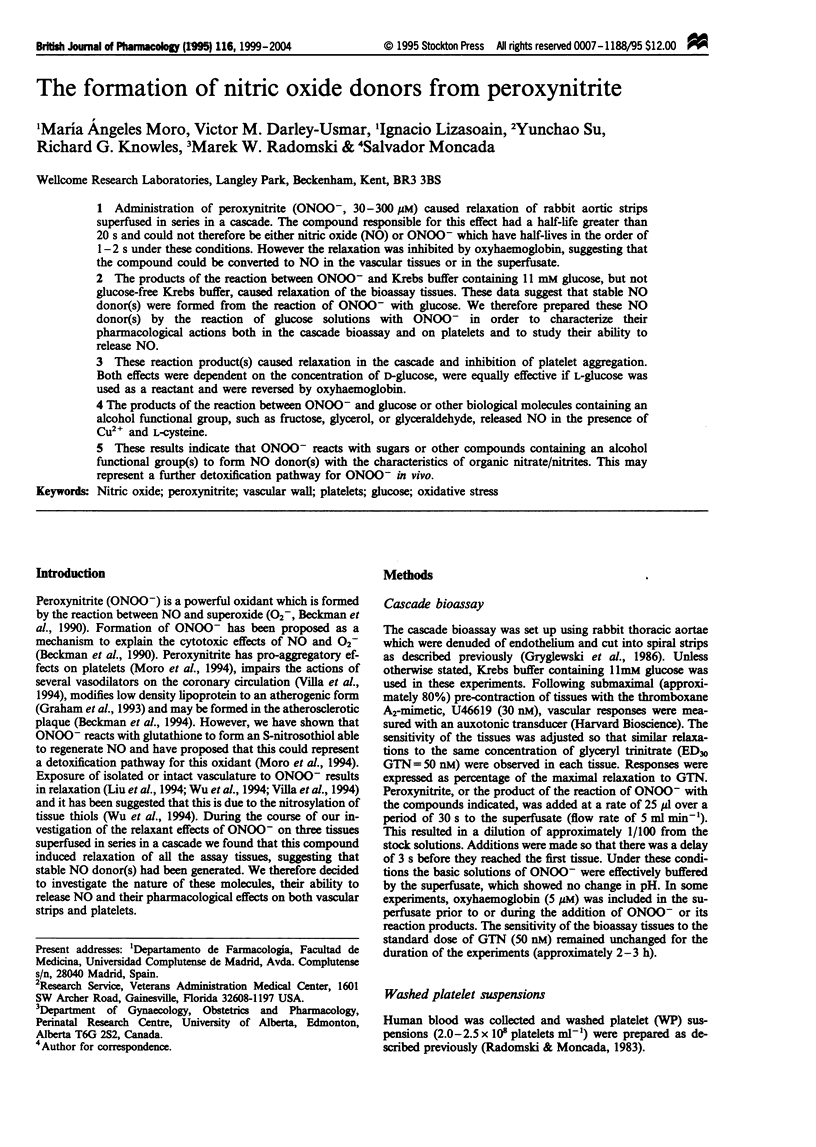
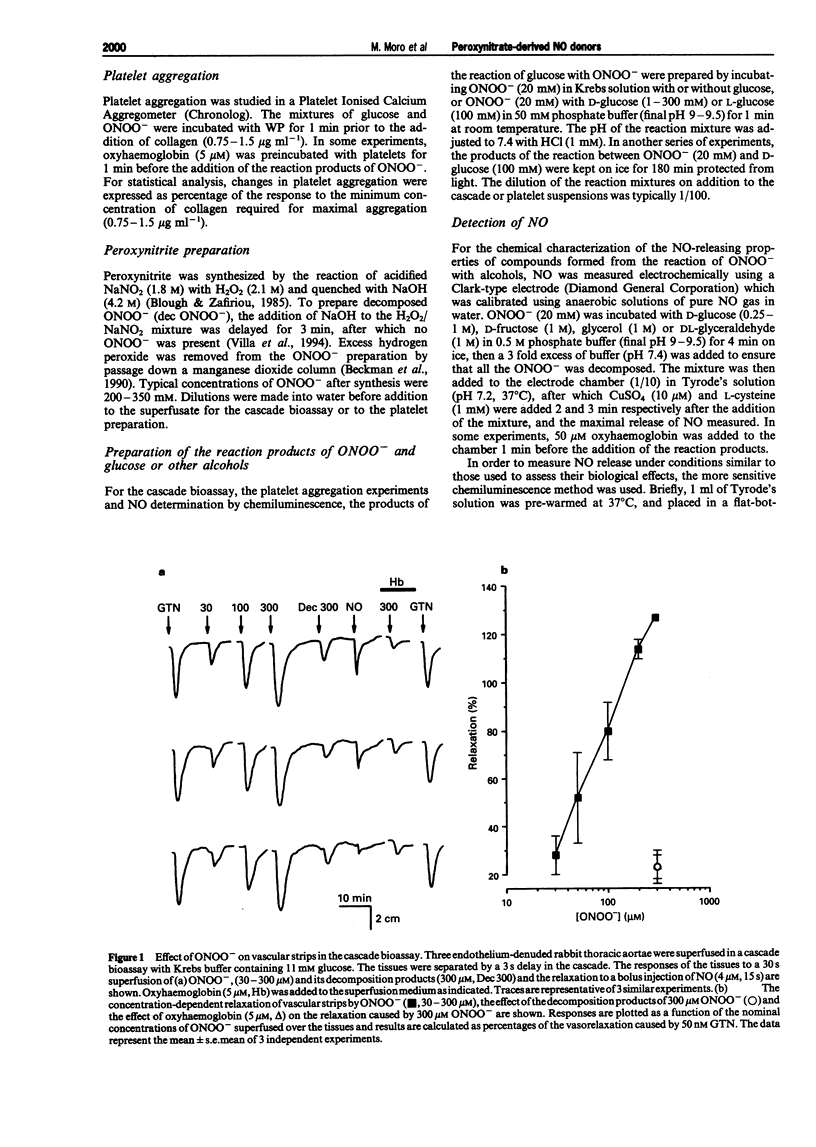
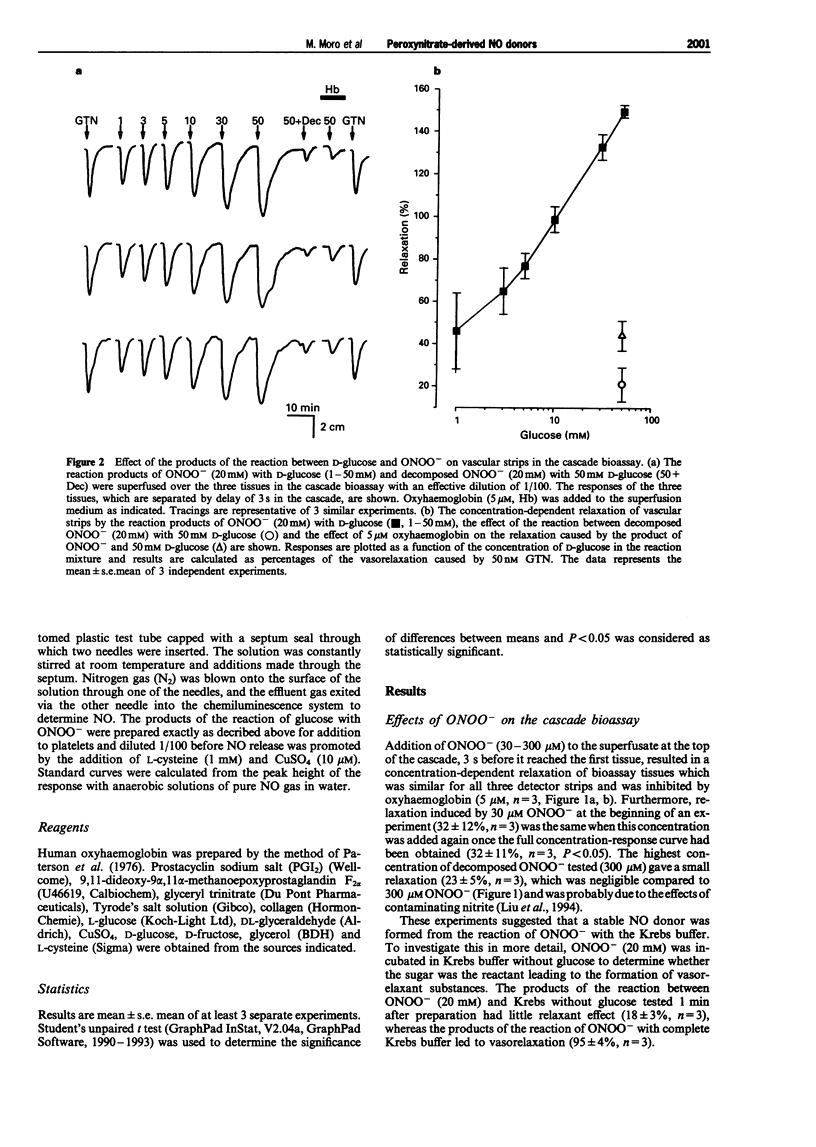
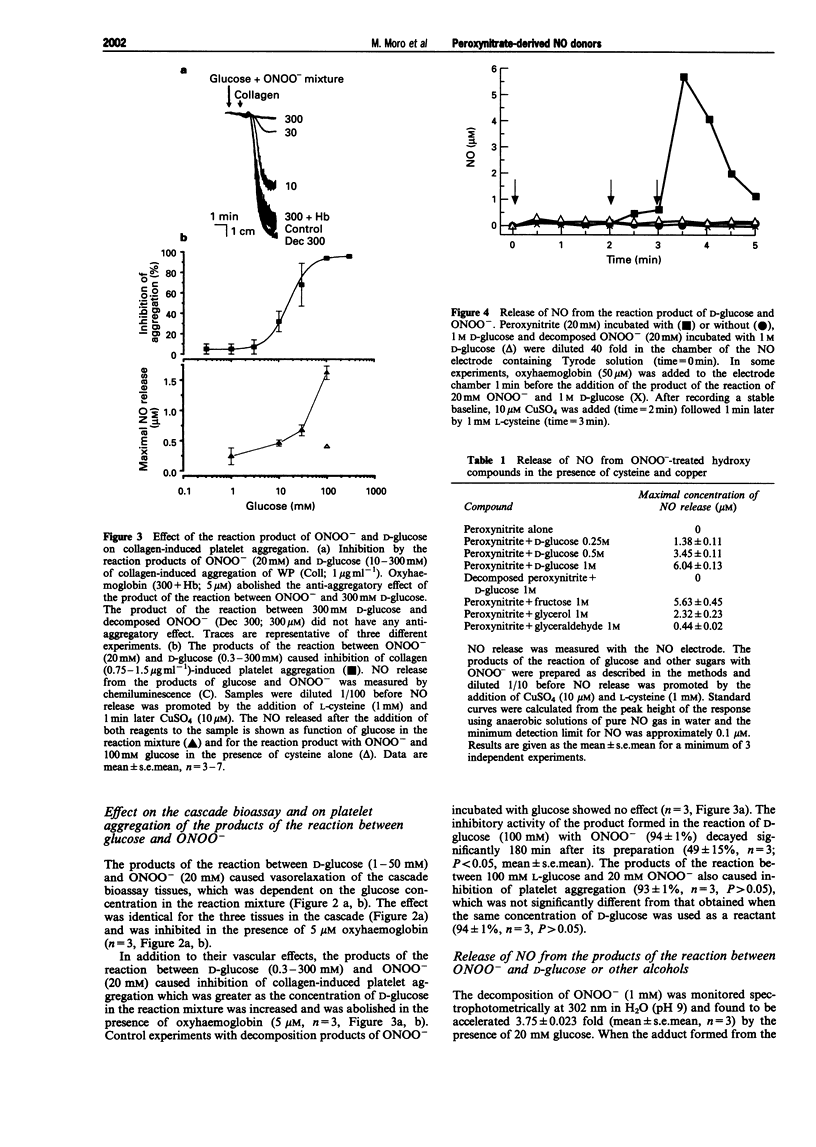
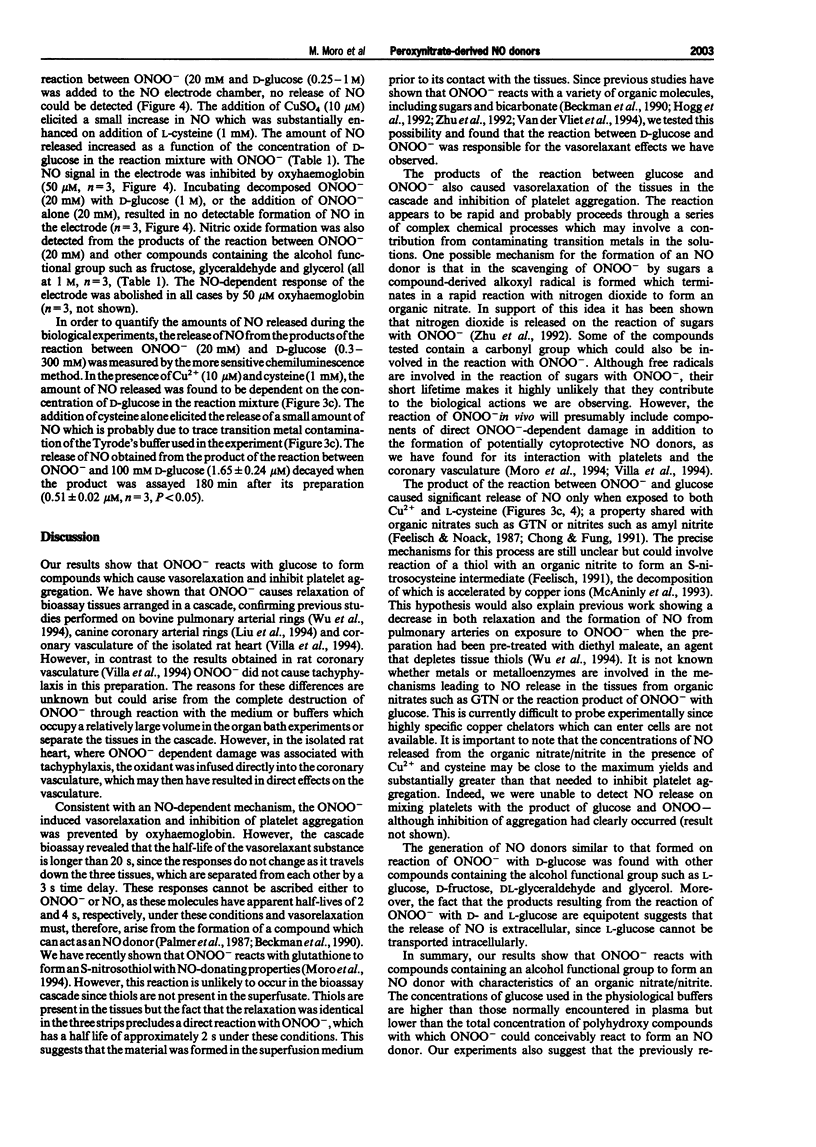

Selected References
These references are in PubMed. This may not be the complete list of references from this article.
- Beckman J. S., Beckman T. W., Chen J., Marshall P. A., Freeman B. A. Apparent hydroxyl radical production by peroxynitrite: implications for endothelial injury from nitric oxide and superoxide. Proc Natl Acad Sci U S A. 1990 Feb;87(4):1620–1624. doi: 10.1073/pnas.87.4.1620. [DOI] [PMC free article] [PubMed] [Google Scholar]
- Beckmann J. S., Ye Y. Z., Anderson P. G., Chen J., Accavitti M. A., Tarpey M. M., White C. R. Extensive nitration of protein tyrosines in human atherosclerosis detected by immunohistochemistry. Biol Chem Hoppe Seyler. 1994 Feb;375(2):81–88. doi: 10.1515/bchm3.1994.375.2.81. [DOI] [PubMed] [Google Scholar]
- Chong S., Fung H. L. Biochemical and pharmacological interactions between nitroglycerin and thiols. Effects of thiol structure on nitric oxide generation and tolerance reversal. Biochem Pharmacol. 1991 Sep 12;42(7):1433–1439. doi: 10.1016/0006-2952(91)90456-f. [DOI] [PubMed] [Google Scholar]
- Feelisch M., Noack E. A. Correlation between nitric oxide formation during degradation of organic nitrates and activation of guanylate cyclase. Eur J Pharmacol. 1987 Jul 2;139(1):19–30. doi: 10.1016/0014-2999(87)90493-6. [DOI] [PubMed] [Google Scholar]
- Graham A., Hogg N., Kalyanaraman B., O'Leary V., Darley-Usmar V., Moncada S. Peroxynitrite modification of low-density lipoprotein leads to recognition by the macrophage scavenger receptor. FEBS Lett. 1993 Sep 13;330(2):181–185. doi: 10.1016/0014-5793(93)80269-z. [DOI] [PubMed] [Google Scholar]
- Gryglewski R. J., Moncada S., Palmer R. M. Bioassay of prostacyclin and endothelium-derived relaxing factor (EDRF) from porcine aortic endothelial cells. Br J Pharmacol. 1986 Apr;87(4):685–694. doi: 10.1111/j.1476-5381.1986.tb14586.x. [DOI] [PMC free article] [PubMed] [Google Scholar]
- Hogg N., Darley-Usmar V. M., Wilson M. T., Moncada S. Production of hydroxyl radicals from the simultaneous generation of superoxide and nitric oxide. Biochem J. 1992 Jan 15;281(Pt 2):419–424. doi: 10.1042/bj2810419. [DOI] [PMC free article] [PubMed] [Google Scholar]
- Liu S., Beckman J. S., Ku D. D. Peroxynitrite, a product of superoxide and nitric oxide, produces coronary vasorelaxation in dogs. J Pharmacol Exp Ther. 1994 Mar;268(3):1114–1121. [PubMed] [Google Scholar]
- Moro M. A., Darley-Usmar V. M., Goodwin D. A., Read N. G., Zamora-Pino R., Feelisch M., Radomski M. W., Moncada S. Paradoxical fate and biological action of peroxynitrite on human platelets. Proc Natl Acad Sci U S A. 1994 Jul 5;91(14):6702–6706. doi: 10.1073/pnas.91.14.6702. [DOI] [PMC free article] [PubMed] [Google Scholar]
- Palmer R. M., Ferrige A. G., Moncada S. Nitric oxide release accounts for the biological activity of endothelium-derived relaxing factor. Nature. 1987 Jun 11;327(6122):524–526. doi: 10.1038/327524a0. [DOI] [PubMed] [Google Scholar]
- Radomski M., Moncada S. An improved method for washing of human platelets with prostacyclin. Thromb Res. 1983 May 15;30(4):383–389. doi: 10.1016/0049-3848(83)90230-x. [DOI] [PubMed] [Google Scholar]
- Van der Vliet A., Smith D., O'Neill C. A., Kaur H., Darley-Usmar V., Cross C. E., Halliwell B. Interactions of peroxynitrite with human plasma and its constituents: oxidative damage and antioxidant depletion. Biochem J. 1994 Oct 1;303(Pt 1):295–301. doi: 10.1042/bj3030295. [DOI] [PMC free article] [PubMed] [Google Scholar]
- Villa L. M., Salas E., Darley-Usmar V. M., Radomski M. W., Moncada S. Peroxynitrite induces both vasodilatation and impaired vascular relaxation in the isolated perfused rat heart. Proc Natl Acad Sci U S A. 1994 Dec 20;91(26):12383–12387. doi: 10.1073/pnas.91.26.12383. [DOI] [PMC free article] [PubMed] [Google Scholar]
- Wu M., Pritchard K. A., Jr, Kaminski P. M., Fayngersh R. P., Hintze T. H., Wolin M. S. Involvement of nitric oxide and nitrosothiols in relaxation of pulmonary arteries to peroxynitrite. Am J Physiol. 1994 May;266(5 Pt 2):H2108–H2113. doi: 10.1152/ajpheart.1994.266.5.H2108. [DOI] [PubMed] [Google Scholar]
- Zhu L., Gunn C., Beckman J. S. Bactericidal activity of peroxynitrite. Arch Biochem Biophys. 1992 Nov 1;298(2):452–457. doi: 10.1016/0003-9861(92)90434-x. [DOI] [PubMed] [Google Scholar]


